|
April 17, 2022
Dear Neighbors and Friends,
I hope that you and your loved ones are doing well, staying healthy, and looking out for your neighbors and friends during this past week. If you and your family celebrate Passover, Easter, Ramadan, some combination or other, I do hope that it was an enjoyable, meaningful holiday weekend. If you're like me, I'm sure you found yourself thinking about how the messages of these holy days can help us ponder and perhaps address the tragic, horrific war carnage that continues to unfold in Ukraine.
Sorry this newsletter is a few days later than usual, but I suddenly found myself facing holiday, tax-filing, and other exigencies. Tonight’s newsletter will be entirely COVID-related, with data and analysis going back to Thursday. I’ll have more to say about legislative affairs in Thursday’s.
However, I do want to share with you some late-breaking news related to the Capitol remodel. A couple of weeks ago, I gave you the sad news that the Senate chamber will need to be kept closed for the final two years of my term and that we would be crammed into one of the hearing rooms instead. Well, as a result of some rejiggering and stretching out of the work, in fact we will be able to hold floor sessions in the chamber during both the long 2023 session and the short 2022 session. In addition, the Senate floor will be open for the confirmation votes on Governor appointments during the Legislative Days occurring in May, September, and December. (The committee and task force meetings those weeks will need to remain virtual for the remainder of this year.) Not all of the entrances will be open (details are still being developed), but overall this is great news.
On the COVID front, we remain in wait-and-see mode, as the highly-infectious BA.2 Omicron variant continues to spread and infect a growing number of Oregonians. Hospitalizations are fortunately continuing to go down slightly here in Oregon, so we’re not (yet) seeing the effects of those higher numbers. There is continuing to be growing evidence that boosters are making a difference in protecting older people from serious infection, so if you have not yet gotten one, you should.
We’re seeing more and more people appearing in indoor public places without masks, but that’s certainly not universal here in the Portland area. I was at a conference the other day (explaining the details of the new Future Ready Oregon workforce-development investments), where few attendees wore masks. Then two days later I was inside Franklin High School to visit its Student-Based Health Center and hear from students who use it. (They love it and really appreciate its convenience and supportive mission.) I would say that at least ¾ of the students and teachers that I saw in the hallways between classes were wearing masks. That wasn’t what I expected. Students that I talked to said that they were very happy to be back in the building but just felt more comfortable wearing masks—which they considered no big deal—given the number of people they know who are still getting sick.
I’m still planning to have my next Constituent Coffee—on May 7th—be in-person at the Hollywood Senior Center. Fingers-crossed we’ll still be able to do it that way. I’m really looking forward to it. Having said that, I know that many of you have come to enjoy and appreciate the convenience of the zoom coffees, so I’m planning to alternate between the two modalities in the coming months.
In Thursday’s newsletter I’ll let you know about more of the interim work that’s going on, along with more about the Criminal Justice bills that passed and didn’t pass in February.
Until then, please stay healthy and safe. And let me know if you have any questions or thoughts about anything in tonight’s newsletter.
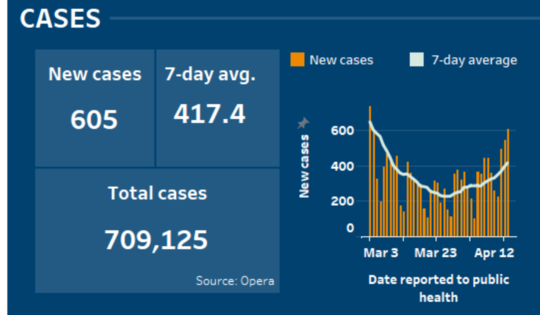

Weekly Report: Continuing Increases in New Cases in Oregon
OHA didn’t produce a weekly report this week (they’re on an every-other-week cycle). We’ll get their next weekly update next Wednesday. In the meantime, here is some high-level information that can help let us know where we appear to be headed here in Oregon. At the end of the newsletter you’ll find graphs that I’ve put together showing the daily counts and trends for the last two weeks.
- OHA reported 2,873 new cases of COVID-19 during the week of April 8-14, an increase of 44.5% over last week’s 1,988. As you’ll see below, this increase is again at least in part due to an uptick in testing and a slight increase in the test positivity rate. The number of new cases is again likely an undercount, as many people are using home tests to determine their infection status but are not reporting those results.
- On Thursday there were 101 COVID-19-related hospitalizations, a slight increase from last week’s 97, but still very low. The number of COVID patients in Oregon’s ICUs was 15, another extremely low number.
- There were 146 reported COVID-19-related deaths, up slightly from 144 the previous week.
- Reported COVID-19 test results declined slightly last week. There were 72,132 tests administered, vs. 78,387 last week.
- Test positivity on Thursday was 5.4%, another increase from last week’s 3.8%.
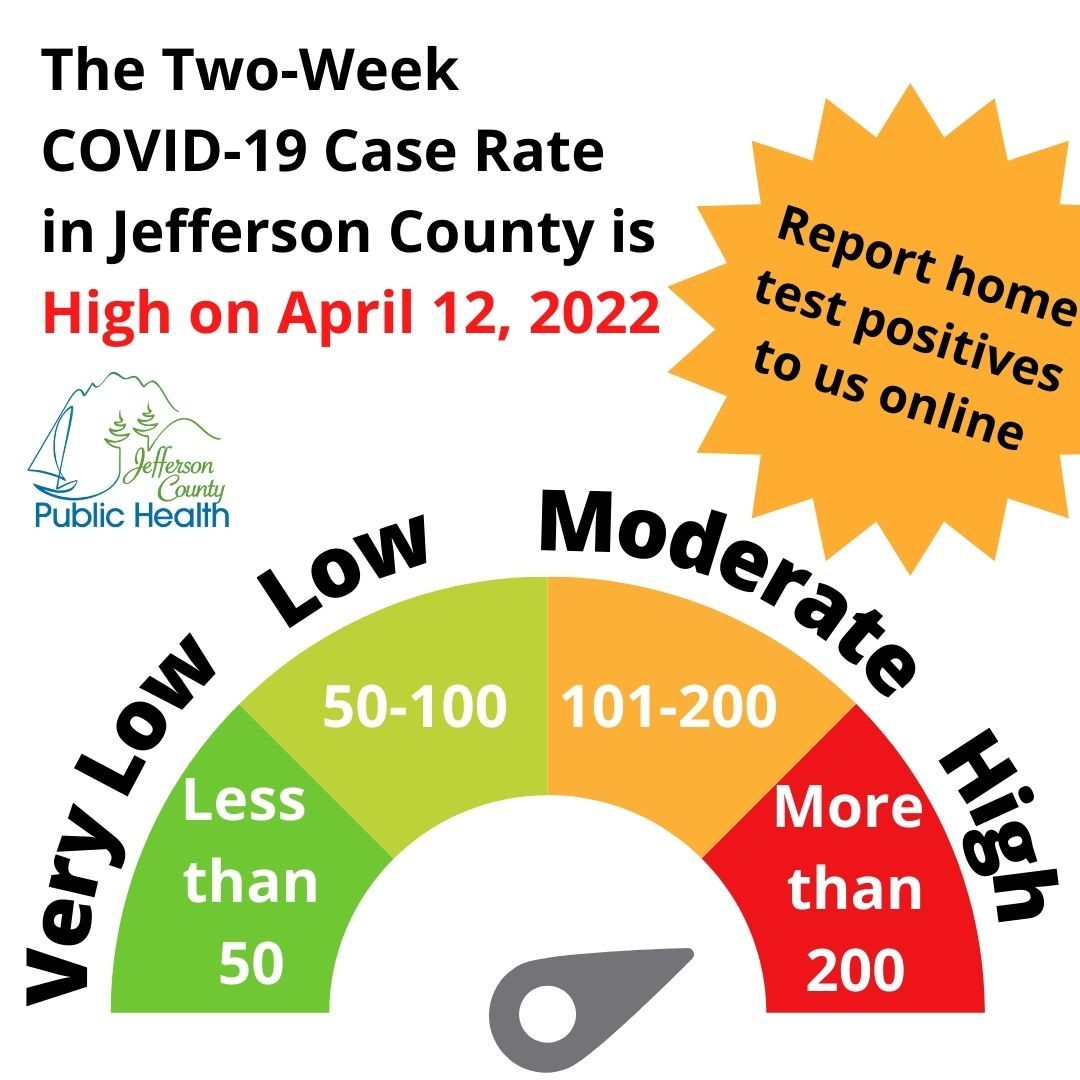
Weekly County Report: Continuing Increases in Test Positivity Rates
OHA is no longer providing a weekly county report each Monday. However, you can track the test positivity rates for each county and the state as a whole at this dashboard.
The test positivity rates reported this week remain at relatively low levels, but they are again going up.
The statewide infection rate has gone from 3.4% last week to 4.8% this week. This is still low but something to watch.
Multnomah County is now above the state average, at 6.8%, up from 3.2% last week.

New OHSU Forecast Continues to Show Declines, Predicts Increases
The current OHSU forecast report, published last Friday, uses data provided by OHA and others that project how fast the virus may spread in the population and provides projections on possible outcomes, including infection rates and impacts on hospital capacity. The lead author is Dr. Peter Graven, Director of OHSU’s Office of Advanced Analytics. It appears every two weeks.
This forecast shows that the declines in hospitalizations are continuing. Dr. Graven is predicting that we will likely see some increases, following the increases in cases and test positivity rates. The current forecast predicts a gradual increase to 2 to 3 times the current number of hospitalizations (currently around 100) in the next few months, including those who were not admitted for COVID but tested positive upon admission (making their in-hospital treatment more complicated). These increases would be due both to the BA.2 subvariant and the relaxation of masking and distancing requirements. However, even at this level, COVID hospitalizations should still remain well below danger levels for our hospitals.
Here are key observations in last week’s report:
- As of April 8, 99 patients were in Oregon hospitals, down by 58 patients over two weeks.
- The Northeast is seeing consistent case increases, though hospitalizations rose only in Vermont.
- Cases and the number of people in hospitals remain low across Oregon.
- The rate of masking in Oregon has plummeted to 36% since restrictions were lifted March 12. That's down from 74% four weeks earlier.
- The BA.2 omicron variant is dominant in Oregon.
- As of April 5, 3% of occupied ICU beds had COVID patients in them statewide, down from 5% two weeks before.
- Five children were in Oregon hospitals, similar to the level before the omicron surge.
- COVID deaths per day continue to be revised up in historical data, but low rates are expected over the next three months.
- Flu cases remain low in Oregon. Denmark is seeing a surprising increase, though, and South America appears to be seeing a more sustained increase as it enters its fall season.
- Infections are expected to increase moderately and lead to an increase in the hospitalized population of 2-3 times more than current.
OHA Updates Its Wastewater Monitoring Site
Thanks to ongoing wastewater monitoring, OHA is able to keep an eye on the presence of COVID in communities before it shows up in in individual tests. This is particularly important now that much our testing is occurring at home through private rapid tests.
OHA has a dashboard site that allows you to see the results around the state, with circles indicating whether the amount of COVID in a city is increasing, decreasing, or remaining steady.
The cities of Albany and Hillsboro are unfortunately showing sustained increases right now.
If you click on a city circle, you can get more information about the city, including the presence of COVID in the city’s wastewater over time.
You can check it out here.
Additional COVID Updates and Links
- What we know now about the course of a COVID illness.
- We now have a new method for COVID testing: the InspecIR COVID-19 Breathalizer. How well does it work?
- The federal “test to treat” program, where a person can receive a COVID test at a pharmacy and immediately receive antivirals if the test result is positive, is having trouble getting off the ground. is having trouble getting off the ground.
- As you can see in the above reports for Oregon, COVID test positivity rates are creeping back up again, likely because most of those getting tested in a public setting are more seriously ill or have already had a positive result on an at-home test. Health professionals in Boston are becoming concerned.
- What’s to be done now to stay on top of the trajectory of the pandemic, particularly now that test results are being publicly reported less and less? Here are some thoughts.
- Here’s more about the usefulness of wastewater monitoring in tracking COVID right now.
- Probably the biggest concern with the COVID vaccine has been the potential of it leading to myocarditis, a heart ailment. A recent study shows that the risk is no greater than it is for a non-COVID vaccine.
- For now, the CDC is continuing to require masks on flights and public transit. (Now that I'm back to riding the bus for downtown meetings, I appreciate that the requirement is being maintained, at least for now.)
- The Secretary of Health and Human Services (HHS) has renewed the federal declaration of a health emergency.
- Philadelphia is the first major city to reinstate masking requirements as a result of rising cases.
- Researchers have been surveying doctors about their own vaccine hesitancy. The percentage is surprisingly high, but unsurprisingly connected to their political stances. Here's more.
- More on the efficacy of the second booster for older people.
- The Commonwealth Fund has released the results of a new study of averted costs for medical care, hospitalizations, and deaths as a result of COVID vaccinations.
- Even as hospitalizations overall are going down now, COVID is still doing disproportionately greater harm to communities of color.
- Here are some of the differences in symptoms between Delta and Omicron.


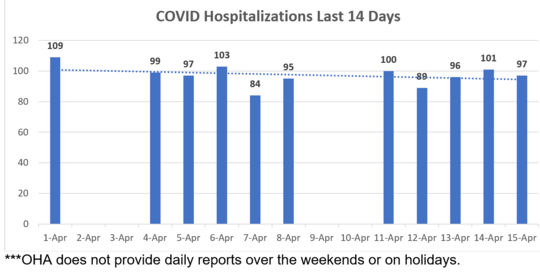
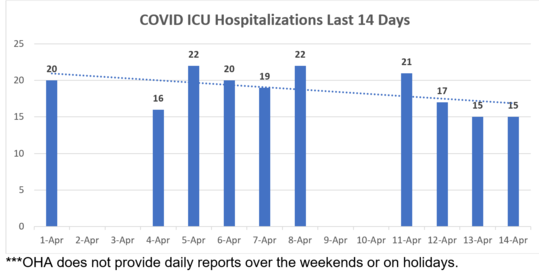

The following graph from OHA will show you the number of COVID deaths as they actually occurred (rather than when they were reported). It is of course always subject to change as additional deaths are reported.
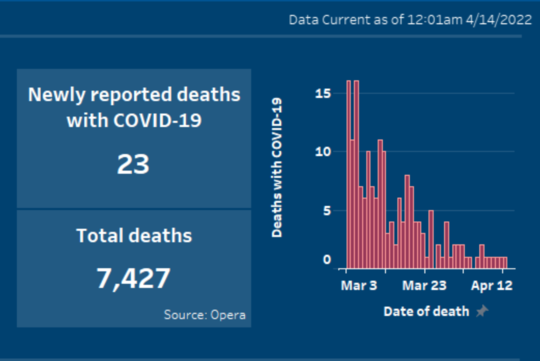 
Here again are some COVID resources that you will find useful
If the above links are not providing you with answers to your questions or directing you to the help that you need, please consider me and my office to be a resource. We’ll do our best to assist you or steer you in the right direction.
Want to See Past Newsletters?
If there was COVID-related information in a past newsletter that you want to go back to, but find you’ve deleted it, you can always go to my legislative website (senatordembrow.com), click on “News and Information,” and you’ll find them all there. Also, if someone forwarded you this newsletter and you’d like to get it directly, you can sign up for it there.
Best,
 Senator Michael Dembrow
District 23
email: Sen.MichaelDembrow@oregonlegislature.gov
web: www.senatordembrow.com
phone: 503-281-0608
mail: 900 Court St NE, S-407, Salem, OR, 97301
|